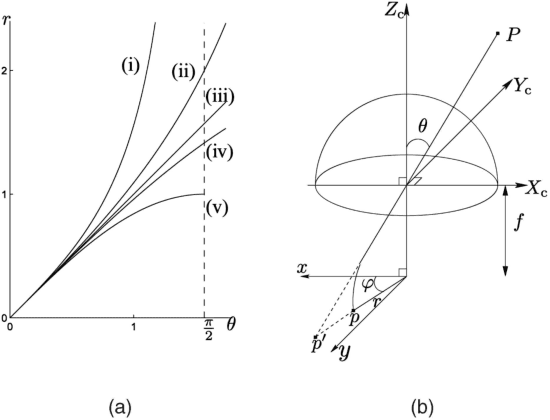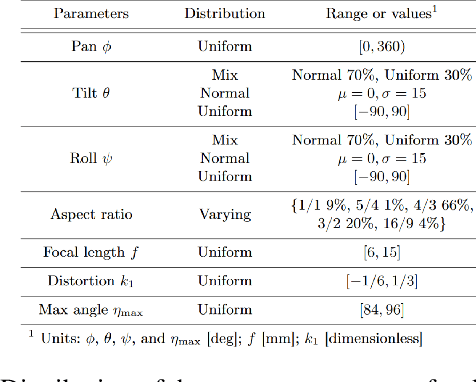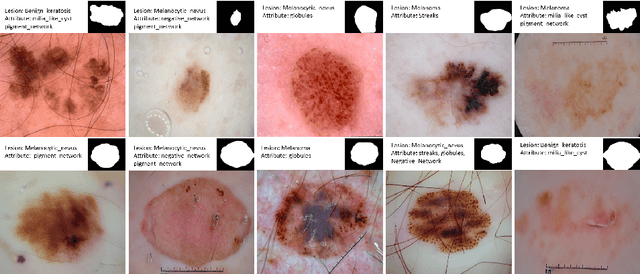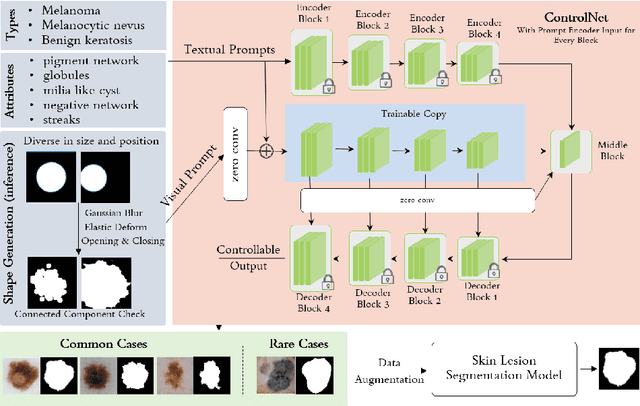Kang Li
Memory-Efficient Prompt Tuning for Incremental Histopathology Classification
Jan 22, 2024Abstract:Recent studies have made remarkable progress in histopathology classification. Based on current successes, contemporary works proposed to further upgrade the model towards a more generalizable and robust direction through incrementally learning from the sequentially delivered domains. Unlike previous parameter isolation based approaches that usually demand massive computation resources during model updating, we present a memory-efficient prompt tuning framework to cultivate model generalization potential in economical memory cost. For each incoming domain, we reuse the existing parameters of the initial classification model and attach lightweight trainable prompts into it for customized tuning. Considering the domain heterogeneity, we perform decoupled prompt tuning, where we adopt a domain-specific prompt for each domain to independently investigate its distinctive characteristics, and one domain-invariant prompt shared across all domains to continually explore the common content embedding throughout time. All domain-specific prompts will be appended to the prompt bank and isolated from further changes to prevent forgetting the distinctive features of early-seen domains. While the domain-invariant prompt will be passed on and iteratively evolve by style-augmented prompt refining to improve model generalization capability over time. In specific, we construct a graph with existing prompts and build a style-augmented graph attention network to guide the domain-invariant prompt exploring the overlapped latent embedding among all delivered domains for more domain generic representations. We have extensively evaluated our framework with two histopathology tasks, i.e., breast cancer metastasis classification and epithelium-stroma tissue classification, where our approach yielded superior performance and memory efficiency over the competing methods.
Evaluating and Enhancing Large Language Models Performance in Domain-specific Medicine: Osteoarthritis Management with DocOA
Jan 20, 2024Abstract:The efficacy of large language models (LLMs) in domain-specific medicine, particularly for managing complex diseases such as osteoarthritis (OA), remains largely unexplored. This study focused on evaluating and enhancing the clinical capabilities of LLMs in specific domains, using osteoarthritis (OA) management as a case study. A domain specific benchmark framework was developed, which evaluate LLMs across a spectrum from domain-specific knowledge to clinical applications in real-world clinical scenarios. DocOA, a specialized LLM tailored for OA management that integrates retrieval-augmented generation (RAG) and instruction prompts, was developed. The study compared the performance of GPT-3.5, GPT-4, and a specialized assistant, DocOA, using objective and human evaluations. Results showed that general LLMs like GPT-3.5 and GPT-4 were less effective in the specialized domain of OA management, particularly in providing personalized treatment recommendations. However, DocOA showed significant improvements. This study introduces a novel benchmark framework which assesses the domain-specific abilities of LLMs in multiple aspects, highlights the limitations of generalized LLMs in clinical contexts, and demonstrates the potential of tailored approaches for developing domain-specific medical LLMs.
Amplifying robotics capacities with a human touch: An immersive low-latency panoramic remote system
Jan 09, 2024Abstract:AI and robotics technologies have witnessed remarkable advancements in the past decade, revolutionizing work patterns and opportunities in various domains. The application of these technologies has propelled society towards an era of symbiosis between humans and machines. To facilitate efficient communication between humans and intelligent robots, we propose the "Avatar" system, an immersive low-latency panoramic human-robot interaction platform. We have designed and tested a prototype of a rugged mobile platform integrated with edge computing units, panoramic video capture devices, power batteries, robot arms, and network communication equipment. Under favorable network conditions, we achieved a low-latency high-definition panoramic visual experience with a delay of 357ms. Operators can utilize VR headsets and controllers for real-time immersive control of robots and devices. The system enables remote control over vast physical distances, spanning campuses, provinces, countries, and even continents (New York to Shenzhen). Additionally, the system incorporates visual SLAM technology for map and trajectory recording, providing autonomous navigation capabilities. We believe that this intuitive system platform can enhance efficiency and situational experience in human-robot collaboration, and with further advancements in related technologies, it will become a versatile tool for efficient and symbiotic cooperation between AI and humans.
Large language models in bioinformatics: applications and perspectives
Jan 08, 2024Abstract:Large language models (LLMs) are a class of artificial intelligence models based on deep learning, which have great performance in various tasks, especially in natural language processing (NLP). Large language models typically consist of artificial neural networks with numerous parameters, trained on large amounts of unlabeled input using self-supervised or semi-supervised learning. However, their potential for solving bioinformatics problems may even exceed their proficiency in modeling human language. In this review, we will present a summary of the prominent large language models used in natural language processing, such as BERT and GPT, and focus on exploring the applications of large language models at different omics levels in bioinformatics, mainly including applications of large language models in genomics, transcriptomics, proteomics, drug discovery and single cell analysis. Finally, this review summarizes the potential and prospects of large language models in solving bioinformatic problems.
A Comprehensive Overview of Fish-Eye Camera Distortion Correction Methods
Dec 31, 2023

Abstract:The fisheye camera, with its unique wide field of view and other characteristics, has found extensive applications in various fields. However, the fisheye camera suffers from significant distortion compared to pinhole cameras, resulting in distorted images of captured objects. Fish-eye camera distortion is a common issue in digital image processing, requiring effective correction techniques to enhance image quality. This review provides a comprehensive overview of various methods used for fish-eye camera distortion correction. The article explores the polynomial distortion model, which utilizes polynomial functions to model and correct radial distortions. Additionally, alternative approaches such as panorama mapping, grid mapping, direct methods, and deep learning-based methods are discussed. The review highlights the advantages, limitations, and recent advancements of each method, enabling readers to make informed decisions based on their specific needs.
PointJEM: Self-supervised Point Cloud Understanding for Reducing Feature Redundancy via Joint Entropy Maximization
Dec 06, 2023Abstract:Most deep learning-based point cloud processing methods are supervised and require large scale of labeled data. However, manual labeling of point cloud data is laborious and time-consuming. Self-supervised representation learning can address the aforementioned issue by learning robust and generalized representations from unlabeled datasets. Nevertheless, the embedded features obtained by representation learning usually contain redundant information, and most current methods reduce feature redundancy by linear correlation constraints. In this paper, we propose PointJEM, a self-supervised representation learning method applied to the point cloud field. PointJEM comprises an embedding scheme and a loss function based on joint entropy. The embedding scheme divides the embedding vector into different parts, each part can learn a distinctive feature. To reduce redundant information in the features, PointJEM maximizes the joint entropy between the different parts, thereby rendering the learned feature variables pairwise independent. To validate the effectiveness of our method, we conducted experiments on multiple datasets. The results demonstrate that our method can significantly reduce feature redundancy beyond linear correlation. Furthermore, PointJEM achieves competitive performance in downstream tasks such as classification and segmentation.
PointMoment:Mixed-Moment-based Self-Supervised Representation Learning for 3D Point Clouds
Dec 06, 2023Abstract:Large and rich data is a prerequisite for effective training of deep neural networks. However, the irregularity of point cloud data makes manual annotation time-consuming and laborious. Self-supervised representation learning, which leverages the intrinsic structure of large-scale unlabelled data to learn meaningful feature representations, has attracted increasing attention in the field of point cloud research. However, self-supervised representation learning often suffers from model collapse, resulting in reduced information and diversity of the learned representation, and consequently degrading the performance of downstream tasks. To address this problem, we propose PointMoment, a novel framework for point cloud self-supervised representation learning that utilizes a high-order mixed moment loss function rather than the conventional contrastive loss function. Moreover, our framework does not require any special techniques such as asymmetric network architectures, gradient stopping, etc. Specifically, we calculate the high-order mixed moment of the feature variables and force them to decompose into products of their individual moment, thereby making multiple variables more independent and minimizing the feature redundancy. We also incorporate a contrastive learning approach to maximize the feature invariance under different data augmentations of the same point cloud. Experimental results show that our approach outperforms previous unsupervised learning methods on the downstream task of 3D point cloud classification and segmentation.
Boosting Dermatoscopic Lesion Segmentation via Diffusion Models with Visual and Textual Prompts
Oct 04, 2023



Abstract:Image synthesis approaches, e.g., generative adversarial networks, have been popular as a form of data augmentation in medical image analysis tasks. It is primarily beneficial to overcome the shortage of publicly accessible data and associated quality annotations. However, the current techniques often lack control over the detailed contents in generated images, e.g., the type of disease patterns, the location of lesions, and attributes of the diagnosis. In this work, we adapt the latest advance in the generative model, i.e., the diffusion model, with the added control flow using lesion-specific visual and textual prompts for generating dermatoscopic images. We further demonstrate the advantage of our diffusion model-based framework over the classical generation models in both the image quality and boosting the segmentation performance on skin lesions. It can achieve a 9% increase in the SSIM image quality measure and an over 5% increase in Dice coefficients over the prior arts.
JAX-LOB: A GPU-Accelerated limit order book simulator to unlock large scale reinforcement learning for trading
Aug 25, 2023



Abstract:Financial exchanges across the world use limit order books (LOBs) to process orders and match trades. For research purposes it is important to have large scale efficient simulators of LOB dynamics. LOB simulators have previously been implemented in the context of agent-based models (ABMs), reinforcement learning (RL) environments, and generative models, processing order flows from historical data sets and hand-crafted agents alike. For many applications, there is a requirement for processing multiple books, either for the calibration of ABMs or for the training of RL agents. We showcase the first GPU-enabled LOB simulator designed to process thousands of books in parallel, with a notably reduced per-message processing time. The implementation of our simulator - JAX-LOB - is based on design choices that aim to best exploit the powers of JAX without compromising on the realism of LOB-related mechanisms. We integrate JAX-LOB with other JAX packages, to provide an example of how one may address an optimal execution problem with reinforcement learning, and to share some preliminary results from end-to-end RL training on GPUs.
Generative AI for End-to-End Limit Order Book Modelling: A Token-Level Autoregressive Generative Model of Message Flow Using a Deep State Space Network
Aug 23, 2023Abstract:Developing a generative model of realistic order flow in financial markets is a challenging open problem, with numerous applications for market participants. Addressing this, we propose the first end-to-end autoregressive generative model that generates tokenized limit order book (LOB) messages. These messages are interpreted by a Jax-LOB simulator, which updates the LOB state. To handle long sequences efficiently, the model employs simplified structured state-space layers to process sequences of order book states and tokenized messages. Using LOBSTER data of NASDAQ equity LOBs, we develop a custom tokenizer for message data, converting groups of successive digits to tokens, similar to tokenization in large language models. Out-of-sample results show promising performance in approximating the data distribution, as evidenced by low model perplexity. Furthermore, the mid-price returns calculated from the generated order flow exhibit a significant correlation with the data, indicating impressive conditional forecast performance. Due to the granularity of generated data, and the accuracy of the model, it offers new application areas for future work beyond forecasting, e.g. acting as a world model in high-frequency financial reinforcement learning applications. Overall, our results invite the use and extension of the model in the direction of autoregressive large financial models for the generation of high-frequency financial data and we commit to open-sourcing our code to facilitate future research.
 Add to Chrome
Add to Chrome Add to Firefox
Add to Firefox Add to Edge
Add to Edge